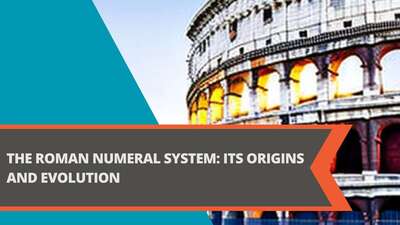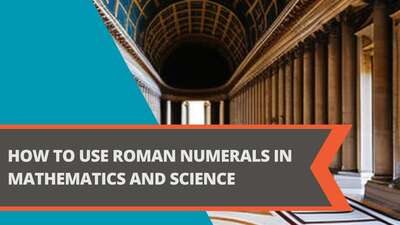How to Use Roman Numerals in Mathematics and Science
Although not commonly used in modern-day math and science, Roman numerals still have practical applications in certain fields. From representing dates and page numbers in books to labeling the parts of a chemical equation, Roman numerals offer a unique and elegant notation system that can be used in a variety of mathematical and scientific contexts. In this post, we'll explore how to use Roman numerals in math and science, and why they continue to be valuable tools for representing numerical information.
The Value of Roman Numerals in Mathematics and Science
While the Arabic numeral system is the most commonly used notation system in modern-day math and science, Roman numerals still hold value as a historical and cultural artifact. In addition, they can be used in certain mathematical and scientific contexts to provide clarity and concision in notation. For example, Roman numerals are often used to label the parts of a chemical equation, as they provide a clear and concise way of indicating the reactants and products involved. They can also be used to represent dates in historical or archaeological contexts, as Roman numerals were commonly used in ancient Rome and other parts of the world during certain periods of history.
Arithmetic with Roman Numerals
Performing arithmetic with Roman numerals can be a bit more challenging than with Arabic numerals, as there is no standardized way of representing zero and negative numbers in the Roman numeral system. However, basic arithmetic operations such as addition, subtraction, multiplication, and division can be performed using Roman numerals. Here is a brief overview of how each operation can be performed:
Addition: To add two Roman numerals together, simply place them side by side and add their values. For example, III + IV = VII. Subtraction: To subtract one Roman numeral from another, place the smaller numeral before the larger numeral and subtract its value from the larger numeral. For example, IV - I = III. Multiplication: To multiply two Roman numerals together, convert them to Arabic numerals, perform the multiplication, and then convert the result back to Roman numerals. For example, V × III = XV. Division: Division with Roman numerals is more complex, and requires the use of fractions and long division. It is not commonly used in modern-day math and science, but was used in ancient Rome and other parts of the world during certain periods of history.Converting Between Roman and Arabic Numerals
Converting between Roman and Arabic numerals is a valuable skill for anyone working in math and science fields. Here is a simple formula for converting Arabic numerals to Roman numerals:
Step 1: Write down the Arabic numeral.
Step 2: Divide the number by the value of the largest possible Roman numeral (M = 1000).
Step 3: Write down the corresponding Roman numeral for each quotient, starting with the largest possible Roman numeral and working your way down.
Step 4: Subtract the product of the quotient and the value of the corresponding Roman numeral from the original number.
Step 5: Repeat steps 2-4 with the remaining number until the entire number has been converted to Roman numerals.
Here is a more detailed example of how to convert Arabic numerals to Roman numerals using this formula:
Example: Convert the Arabic numeral 348 to Roman numerals.
Step 1: Write down the Arabic numeral: 348.
Step 2: Divide 348 by 1000, which gives a quotient of 0 with a remainder of 348.
Step 3: Write down the corresponding Roman numeral for 0 M, which is an empty string: "".
Step 4: Divide 348 by 500, which gives a quotient of 0 with a remainder of 348.
Step 5: Write down the corresponding Roman numeral for 0 D, which is an empty string: "".
Step 6: Divide 348 by 100, which gives a quotient of 3 with a remainder of 48.
Step 7: Write down the corresponding Roman numeral for 3 C, which is CCC.
Step 8: Subtract 300 (the product of 3 and 100) from 348, which gives a remainder of 48.
Step 9: Divide 48 by 50, which gives a quotient of 0 with a remainder of 48.
Step 10: Write down the corresponding Roman numeral for 0 L, which is an empty string: "".
Step 11: Divide 48 by 10, which gives a quotient of 4 with a remainder of 8.
Step 12: Write down the corresponding Roman numeral for 4 X, which is XXXX.
Step 13: Subtract 40 (the product of 4 and 10) from 48, which gives a remainder of 8.
Step 14: Divide 8 by 5, which gives a quotient of 1 with a remainder of 3.
Step 15: Write down the corresponding Roman numeral for 1 V, which is V.
Step 16: Subtract 5 (the product of 1 and 5) from 8, which gives a remainder of 3.
Step 17: Write down the corresponding Roman numeral for 3 I, which is III.
Step 18: Combine all the Roman numerals to get the final result: CCCXLVIII.
Examples of Using Roman Numerals in Mathematics and Science
Here are a few examples of how Roman numerals can be used in mathematical and scientific contexts:
Chemical Equations: Roman numerals are often used to label the parts of a chemical equation, such as reactants and products. Page Numbers: Roman numerals are sometimes used to number pages in books, particularly in the front matter and introduction. Music Theory: Roman numerals are used to indicate chords and chord progressions in music theory. Date Notation: Roman numerals can be used to represent dates in historical and archaeological contexts.Conclusion
In conclusion, although Roman numerals may seem outdated in the world of modern mathematics and science, they still hold value and relevance in certain fields. By understanding how to use Roman numerals, you can expand your knowledge and appreciation of the history and development of numerical systems.
Through this article, we have explored the definition of Roman numerals, the formula for converting them to Arabic numerals, examples of their use in mathematics and science, and an explanation of their continued importance. By using the resources available, such as online converters and charts, you can easily incorporate Roman numerals into your work and gain a deeper understanding of their significance.
So the next time you encounter Roman numerals, whether it be in a historical document, a clock face, or a mathematical equation, take a moment to appreciate their unique qualities and the knowledge they can provide.
For more information on Roman numeral conversion and usage, visit numbersconverter.com.







